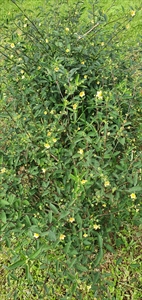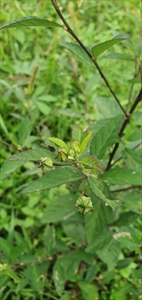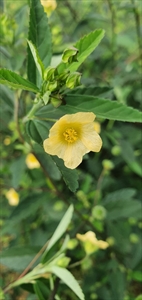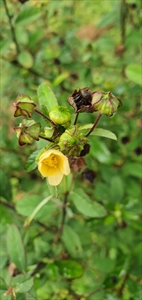Sida; it is also known as spinyhead sida, broom weed.
Pacific Pests, Pathogens, Weeds & Pesticides - Online edition
Pacific Pests, Pathogens, Weeds & Pesticides
Sida (452)
Sida acuta. It was known previously as Sida acuta subspecies carpiunifolia and Sida carpinifolia. It is a member of the Malvaceae.
There are a number of Sida species, with Sida rhombifolia common in the region. It is recorded in all those countries listed for Sida acuta, plus Tokelau, and Wallis and Futuna.
Asia, Africa, North, South and Central America, the Caribbean, Europe (restricted), Oceania. It is recorded from Australia, American Samoa, Cook Islands, Federated States of Micronesia, Fiji, French Polynesia, Guam, Kiribati, Marshall Islands, Nauru, New Caledonia, Niue, Palau, Papua New Guinea, Samoa, Solomon Islands, Tonga, and Vanuatu.
It is native to South America.
A very vigorous weed of disturbed habitats in the sub-tropics and tropics. It is particularly important in pastures and woodland-grassland (i.e., savannah) habitats, but is also in plantations, including forestry, cereal, root and vegetable crops, lawns, along banks of waterways, as well as waste land and roadsides (Photos 1&2). Invasiveness is due to its ability to thrive in a range of soil types and rainfall (the long tap root helps it to withstand droughts), prolific production of seed and its ease of spread. It is found from sea level to 1500 masl.
It is especially problematic where there are marked wet and dry seasons. Cattle avoid the weed, and this can lead to overgrazing which in turn can assist the weed to become established. Goatweed has chemicals that are released into the soil that prevent the growth of competitors (known as allelopathy).
An erect, branched perennial shrub, 30-100 cm tall (occasionally taller), with fibrous to woody stems, and a long, tough taproot. Leaves are spear-shaped, tapering at both ends, with saw-like margins, alternate along the stem, joining with hairy leaf stalks, 3-6 mm long (Photo 3). Flowers, borne on short stalks, 3-8 mm long, arising from the leaf forks, range from light yellow to orange, with five petals joined at the base (Photos 4&5). There are large numbers of stamens (male parts) around the style (central female part) which has 6-10 branches near the tip. The brown hard fruits divide into 5-8, 1-seeded, wedged-shaped parts, each with a pair of stiff bristles (awns), when mature (Photo 6). Seeds require scarification or bacterial action to germinate.
Sida can lose its leaves during a drought and grow back from the rootstock when rains return.
Spread occurs as seed. The two stiff bristles (awns) of each seed attach to farm machinery, vehicles, the fur of animals, and the clothing of people. Spread also occurs in water. Plants with seeds may contaminate hay, and seeds of sida may be harvested together with pasture seeds. Note that cattle may eat sida seeds and these can pass through the gut undamaged.
The weed has had a pronounced economic impact in northern Australia, Papua New Guinea and many Pacific Islands. In Papua New Guinea, it has covered vast areas of the Markham-Ramu valleys following droughts, resulting in the culling of livestock and the increased costs of herbicide use. In Fiji, it is most aggressive in the dry zone in pastures and sugarcane; similarly, in Australia, and throughout the Pacific islands and Southeast Asia, it is a weeds of plantations, root crops, cereals and vegetables.
None reported.
BIOSECURITY
There is a high risk of introduction of this weed. Countries not yet infested should consider all likely pathways for entry, and apply quarantine measures accordingly. Special consideration should be given to sida being a contaminant of pasture seed.
It is considered one of the worst 10 weeds in New Caledonia, Solomon Islands and Vanuatu, and is important in most other Pacific island countries.
BIOLOGICAL CONTROL
Since the late 1980s, the foliage-feeding chrysomelid beetle, Calligrapha pantherina, has been introduced into many countries to control Sida acuta and related Sida species (see Fact sheet no. 352) (Photo 7). These introductions have been successful in reducing seed production, and resulting in restoration of native vegetation. They have been especially useful in Australia, Fiji, Papua New Guinea, and Vanuatu.
The fungus, Fusarium lateritium, has been used for the control of Sida spinosa (spinysida) in the USA, and against Sida acuta, with promising results.
CULTURAL CONTROL
- Physical & Mechanical
- Dig or grub out plants, preferably before flowering and seed set, Hand weeding is not practical because of the tough, fibrous taproot.
- Plough, disc and harrow the land, preferably before the plants have flowered and set seeds. Repeated operations will be needed until seedstocks in the soil have been destroyed.
- Maintenance of pastures
- Do not overgraze; otherwise, sida is likely to re-invade the pastures.
- Cultivate and then sow grass and legume-dense pastures.
- Hygiene
- Treat vehicles and farm machinery. Wash down vehicles first before moving from areas where the weed occurs to those weed-free. Wash to remove soil and seed. Also, ensure seeds are not carried on clothes between infested and 'clean' areas.
CHEMICAL CONTROL
The following are some of the products registered for use on Sida acuta and other Sida species in Australia. In Fiji, glyphosate, immediately after slashing.
- Pre-emergence: pendimethalin.
- Post-emergence: 2,4-D (amine); fluroxypyr; dicamba.
--------------------
Note, in the EU, and approval to use glyphosate ends in December 2022; its use after that date is under discussion.
____________________
When using a pesticide, always wear protective clothing and follow the instructions on the product label, such as dosage, timing of application, and pre-harvest interval. Recommendations will vary with the crop and system of cultivation. Expert advice on the most appropriate herbicides to use should always be sought from local agricultural authorities.
AUTHORS Grahame Jackson, Aradhana Deesh & Mani Mua
Adapted from Spinyhead weed (Sida acuta) (2018) Weeds of SE Qld and Northern NSW. Lucidcentral. (https://play.google.com/store/apps/details?id=com.lucidcentral.mobile.sew_full&hl=en_AU&gl=US); and CABI (2019) Sida acuta (sida). Invasive Species Compendium. (https://www.cabi.org/isc/datasheet/49985); and Sida acuta Burm.f. (2011) Weeds Australia - profiles. (https://profiles.ala.org.au/opus/weeds-australia/profile/Sida%20acuta); and DPI&RD (2020) Sida: pest. Agriculture and Food. Government of Western Australia. (https://www.agric.wa.gov.au/declared-plants/sida-pest); and from Waterhouse DF, Norris KR (1987) Sida acuta. Biological Control Pacific Prospects. Inkata Press, Melbourne;
Produced with support from the Australian Centre for International Agricultural Research under project HORT/2016/185: Responding to emerging pest and disease threats to horticulture in the Pacific islands, implemented by the University of Queensland, in association with the Pacific Community and Koronivia Research Station, Ministry of Agriculture, Fiji.










